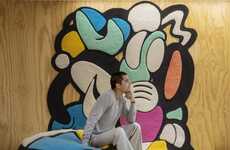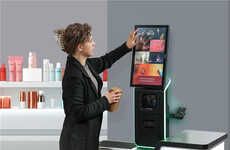In his own words, Allan Chochinov has been given a “decent-sized megaphone” with which to tell design stories thanks to Core77. Allan facilitates discussions about design and its influence daily through Core77, Coroflot.com (a design portfolio community) and his work as a design teacher at Pratt and SVA.
A man of many talents (see his list of hobbies below), Allan Chochinov continues to push the world of design, and he spoke with us about the role trend spotting plays in that work.
13 Questions with Allan Chochinov
1. How did you get involved with Core77 and what motivates you to continue?
Core77 was founded by my two partners, Eric Ludlum and Stuart Constantine, while they were in grad school at Pratt Institute in 1995. I met them when I went back to teach at Pratt just as they were leaving, but the school decided to set them up with an office and a fast Internet connection for a year. I used to hang out there on my lunch hour.
I really love the work, the community, and the place Core77 occupies in the world of design discourse. There are so many amazing design stories to tell right now, and we feel privileged to have a decent-sized megaphone.
2. How significant are the topics of cool hunting and trend spotting to Core77?
They are obviously important, helping us keep our eye on what’s just around the corner. The blog section of our Core77.com site is very popular, and many readers look there for news about what’s hot and what’s cool (often they’re the same thing, of course!). But we also cover topics that wouldn’t fall under labels of cool or trend, in the hope that we can bring attention to them by putting them in a “hot” context like the blog.
We have other, slower-churning sections at the site such as articles, opinion pieces, event coverage and book reviews, but many of the people who contact us with their design objects, services and events “want the blog,” believing that the context in which their stuff is shown matters as much as the content of the stuff itself.
3. How do you define a trend?
Ray Kurzweil wrote that as an inventor he “became interested in long-term trends because an invention has to make sense in the world in which it is finished, not the world in which it is started.” For me this presents a paradox, since so many of the design artifacts and systems I’m interested in exist in either an embryonic phase or a phase where they’ve successfully been launched into the world.
So short-term trends can provide a kind of gratification (some might call it titillation) that has value, though admittedly perhaps not the “timeless” design value that the industry extols. Sometimes this has to do with the consumption of design memes rather than fully-realized designs themselves—something I’ve spoken and written about—and indeed, interest in what’s sometimes referred to as Fictional Design is surging right now.
4. How do you define cool?
Just enough to get you kicked out of school for.
5. Do you need a culture of innovation to create something that is cool?
Well, I’m not sure these two things are necessarily tied. Innovation is a word that has barely a breath left in it these days, but it’s still a good word, and one that has strong resonance with the business community. Michael Bierut once said that he never said to a group of designers, “Now group, let’s INNOVATE!” and I think he’s dead on. Its value may be strongest as an abstract concept rather than a tactical measure. Is it a requisite for creating cool? I doubt it. Cool is imbued outside-in as often as it’s concocted inside-out. Maybe more often.
6. What is the best way to create an infectious idea, product or service?
That is a very expensive question. (Have been dying to use that answer since 1990 when I first heard it. Damned if I can remember from whom.)
7. What is the key to innovation?
I like the usual suspects: Empathy, iteration, early prototyping, user-centeredness, research, questioning authority, hard work. No need for a business book on that one.
8. What is the most important trend you see in your industry?
The field of design is expanding in myriad ways: In public appreciation, in professional practice, in discourse and criticism, in umpteen sites and blogs, and as a way for people to parse the goods and services that seem so important in their lives.
There are new imperatives, of course, and of the most urgent kind: Toxicity, climate change, health, labor practices—sustainability in all its applications and contexts. I’m not sure I would term any of these things “trends,” though as mentioned earlier, there is nothing wrong with getting something up on the broader radar by using the tools and outlets that trends more comfortably use and inhabit.
“Trend” seems to have a built-in expiration date, and though there are lots of developments in the world of design that don’t (and sometimes shouldn’t) last very long, the larger issues of making the world a better place, and ennobling users, workers, and consumers of all stripes, is something we obviously want to last.
9. What are your ambitions for Core77?
We love serving the design community. Our job and portfolio site, Coroflot.com, just hit 150,000 portfolios, and that’s an incredibly large number of creative people all in one place. My ambitions are to help inspire those designers, to contribute to the dialog, and to be a cheerleader of the power of design. Sounds trite, but it’s true.
10. How do you reset yourself to be creative? Do you have any rituals?
I think as in the discussion of “innovation” above, intentionally “being creative” is a fool’s game. Almost none of the creative people I know can be creative on demand; certainly there is a skill set that comes into (repeatable) play, but it’s a cliché that the best ideas come to you when you least expect them. That said, a freshly cleaned desk does seem to do wonders for my disposition (but not my creativity, sadly).
11. Professionally, what do you want to be doing in 10 years?
Yikes. I went into design because there were so many disparate ways to live in it, so deciding what to do with my life has never been something I’ve given much weight to. (There seems to be a trend with this interview! “BE innovative! BE creative! DECIDE what you want to do when you grow up!”) So, no, I just want to see how things unfold. There’s still a ton of mystery in design.
12. What are your most important hobbies?
I’m a freak for trying to learn things with my hands—musical instruments, calligraphy, cooking, sign language, crochet, magic tricks—anything manual. I had a job for several years designing surgical instruments and medical diagnostic equipment. I was in heaven.
13. What is an example of a time where you have thrown away an existing idea to force yourself to find something new?
I think this happens all the time, but ironically, the most common criticism for designers is that they fall in love with their own idea. As a design teacher (I teach one day a week at Pratt and at SVA in New York City), there can be both seduction and danger in that. The idea is essential, I’ve always said, but after that, the idea is the least of what’s involved in getting a design into the real world.
I think your question’s important, because knowing when to throw away an idea, and when to wrestle it to the ground until it begs for mercy is a rare and valuable skill. I’m certain I hold onto ideas much longer than I ought to, but I’m trying to be better.
A man of many talents (see his list of hobbies below), Allan Chochinov continues to push the world of design, and he spoke with us about the role trend spotting plays in that work.
13 Questions with Allan Chochinov
1. How did you get involved with Core77 and what motivates you to continue?
Core77 was founded by my two partners, Eric Ludlum and Stuart Constantine, while they were in grad school at Pratt Institute in 1995. I met them when I went back to teach at Pratt just as they were leaving, but the school decided to set them up with an office and a fast Internet connection for a year. I used to hang out there on my lunch hour.
I really love the work, the community, and the place Core77 occupies in the world of design discourse. There are so many amazing design stories to tell right now, and we feel privileged to have a decent-sized megaphone.
2. How significant are the topics of cool hunting and trend spotting to Core77?
They are obviously important, helping us keep our eye on what’s just around the corner. The blog section of our Core77.com site is very popular, and many readers look there for news about what’s hot and what’s cool (often they’re the same thing, of course!). But we also cover topics that wouldn’t fall under labels of cool or trend, in the hope that we can bring attention to them by putting them in a “hot” context like the blog.
We have other, slower-churning sections at the site such as articles, opinion pieces, event coverage and book reviews, but many of the people who contact us with their design objects, services and events “want the blog,” believing that the context in which their stuff is shown matters as much as the content of the stuff itself.
3. How do you define a trend?
Ray Kurzweil wrote that as an inventor he “became interested in long-term trends because an invention has to make sense in the world in which it is finished, not the world in which it is started.” For me this presents a paradox, since so many of the design artifacts and systems I’m interested in exist in either an embryonic phase or a phase where they’ve successfully been launched into the world.
So short-term trends can provide a kind of gratification (some might call it titillation) that has value, though admittedly perhaps not the “timeless” design value that the industry extols. Sometimes this has to do with the consumption of design memes rather than fully-realized designs themselves—something I’ve spoken and written about—and indeed, interest in what’s sometimes referred to as Fictional Design is surging right now.
4. How do you define cool?
Just enough to get you kicked out of school for.
5. Do you need a culture of innovation to create something that is cool?
Well, I’m not sure these two things are necessarily tied. Innovation is a word that has barely a breath left in it these days, but it’s still a good word, and one that has strong resonance with the business community. Michael Bierut once said that he never said to a group of designers, “Now group, let’s INNOVATE!” and I think he’s dead on. Its value may be strongest as an abstract concept rather than a tactical measure. Is it a requisite for creating cool? I doubt it. Cool is imbued outside-in as often as it’s concocted inside-out. Maybe more often.
6. What is the best way to create an infectious idea, product or service?
That is a very expensive question. (Have been dying to use that answer since 1990 when I first heard it. Damned if I can remember from whom.)
7. What is the key to innovation?
I like the usual suspects: Empathy, iteration, early prototyping, user-centeredness, research, questioning authority, hard work. No need for a business book on that one.
8. What is the most important trend you see in your industry?
The field of design is expanding in myriad ways: In public appreciation, in professional practice, in discourse and criticism, in umpteen sites and blogs, and as a way for people to parse the goods and services that seem so important in their lives.
There are new imperatives, of course, and of the most urgent kind: Toxicity, climate change, health, labor practices—sustainability in all its applications and contexts. I’m not sure I would term any of these things “trends,” though as mentioned earlier, there is nothing wrong with getting something up on the broader radar by using the tools and outlets that trends more comfortably use and inhabit.
“Trend” seems to have a built-in expiration date, and though there are lots of developments in the world of design that don’t (and sometimes shouldn’t) last very long, the larger issues of making the world a better place, and ennobling users, workers, and consumers of all stripes, is something we obviously want to last.
9. What are your ambitions for Core77?
We love serving the design community. Our job and portfolio site, Coroflot.com, just hit 150,000 portfolios, and that’s an incredibly large number of creative people all in one place. My ambitions are to help inspire those designers, to contribute to the dialog, and to be a cheerleader of the power of design. Sounds trite, but it’s true.
10. How do you reset yourself to be creative? Do you have any rituals?
I think as in the discussion of “innovation” above, intentionally “being creative” is a fool’s game. Almost none of the creative people I know can be creative on demand; certainly there is a skill set that comes into (repeatable) play, but it’s a cliché that the best ideas come to you when you least expect them. That said, a freshly cleaned desk does seem to do wonders for my disposition (but not my creativity, sadly).
11. Professionally, what do you want to be doing in 10 years?
Yikes. I went into design because there were so many disparate ways to live in it, so deciding what to do with my life has never been something I’ve given much weight to. (There seems to be a trend with this interview! “BE innovative! BE creative! DECIDE what you want to do when you grow up!”) So, no, I just want to see how things unfold. There’s still a ton of mystery in design.
12. What are your most important hobbies?
I’m a freak for trying to learn things with my hands—musical instruments, calligraphy, cooking, sign language, crochet, magic tricks—anything manual. I had a job for several years designing surgical instruments and medical diagnostic equipment. I was in heaven.
13. What is an example of a time where you have thrown away an existing idea to force yourself to find something new?
I think this happens all the time, but ironically, the most common criticism for designers is that they fall in love with their own idea. As a design teacher (I teach one day a week at Pratt and at SVA in New York City), there can be both seduction and danger in that. The idea is essential, I’ve always said, but after that, the idea is the least of what’s involved in getting a design into the real world.
I think your question’s important, because knowing when to throw away an idea, and when to wrestle it to the ground until it begs for mercy is a rare and valuable skill. I’m certain I hold onto ideas much longer than I ought to, but I’m trying to be better.
Trend Themes
1. Trend Spotting - Continued involvement in the emerging trends and innovative technology is necessary for a business to stay competitive in the market, so trend spotting is a crucial process.
2. Cool Hunting - Identifying cutting-edge ideas, products, and services, that deviate from the usual, is what cool hunting is all about. It will assist companies in staying ahead of the competition by providing them with early access to innovative ideas.
3. Community Building - Community building is essential in the world of design discourse because it provides an opportunity to engage with the audience and gather valuable feedback, leading to better design and product innovation.
Industry Implications
1. Design - Designers should be aware of the current trends in design and technology to create unique products that meet the needs of the market.
2. Marketing - Marketing professionals should work with design experts to stay current in the market and utilize the latest trends to stay ahead of the competition
3. Education - Educators should include trend-spotting and cool-hunting in their coursework, enabling students to become familiar with emerging trends in design and technology.
2.2
Score
Popularity
Activity
Freshness






















